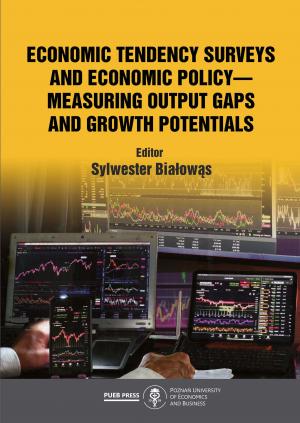
e-ISBN: 978-83-8211-129-3
DOI: 10.18559/978-83-8211-129-3
Edition: I
Publication date: 2022
First publication date: 2022
Pages: 136
Print: paperback
Electronic version: pdf
Format: B5
License : open access
business cycle, business tendency, survey, banks, economic policy, fluctuations, financial behaviour, households, consumption, COVID-19
last week: 6
last 3 months: 105
Edited by
Sylwester Białowąs
Economic tendency surveys and economic policy - measuring output gaps and growth potentials
Availability and purchase
Electronic version(IBUK)Electronic version
(CEEOL)
*Clicking the button takes you to an external open access or selling platform.
The book is available in library subscriptions: Ibuk Libra and EBSCO.
Białowąs, S. (Ed.). (2022). Economic tendency surveys and economic policy - measuring output gaps and growth potentials. Poznań University of Economics and Business Press. https://doi.org/10.18559/978-83-8211-129-3
Business tendency surveys provide information which is valuable to the respondents themselves as well as to economic policy makers and analysts. This is an area of special interest for economists working in governments, national banks, statistical offices and for scientists. CIRET international conferences are the meeting place for top scientists of these areas from worldwide, and they successfully integrate the academic and business communities involved in business surveys and business cycles.
The book contains a selection of topics that have been discussed at 35th CIRET Conference titled Economic Tendency Surveys And Economic Policy: Measuring Output Gaps and Growth Potentials, which took place from 15 to 17 September 2021 in Poznań, Poland. See more on the global and local CIRET Conference websites.
The selection is driven around two goals. In the first part, the articles are related to the research methods, as well as the use regarding a broad range of methods applied in assessing the market economic situation. The second part of the book is focused on the use of methods and situation assessment.
In the presented papers, the variety within the scientific area of business tendency is shown. The work allows to prove the strong position of Polish science in this area as well.
Preface (Sylwester Białowąs)
PART 1. FOCUS ON METHODS
1. Determinants of sample selection in business climate survey within the sector of banking and financial institutions (Radosław Cholewiński, Stanisław Kluza)
2. Use of data from Business Tendency Surveys in output gap estimation (Ewa Ratuszny, Konrad Walczyk)
3. Automatic identification of turning points with HMM-based indicator (Michał Bernardelli)
4. Monetary policy under continuous market sentiment regimes (Michał Chojnowski)
PART 2. SITUATION ASSESSMENT
5. Do survey responses in manufacturing fluctuate with business cycle? Evidence from Poland (Emilia Tomczyk)
6. Anti-inflation policy in Poland’s economy during the period of transformation and integration (Ryszard Barczyk, Zuzanna Urbanowicz)
7. Relationship between cyclical fluctuations in the banking and the services sector in Poland (Robert Skikiewicz)
8. Financial behaviour of households in European Union countries—similarities and differences in the 2004–2016 period (Sylwester Białowąs, Robert Skikiewicz)
9. The propensity of Polish households to consume and save within the context of the COVID-19 pandemic (Jacek Jankiewicz)
Chapters:



 Full text download (pdf)
Full text download (pdf)